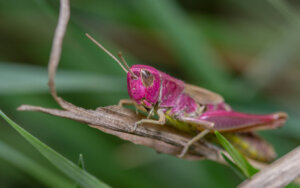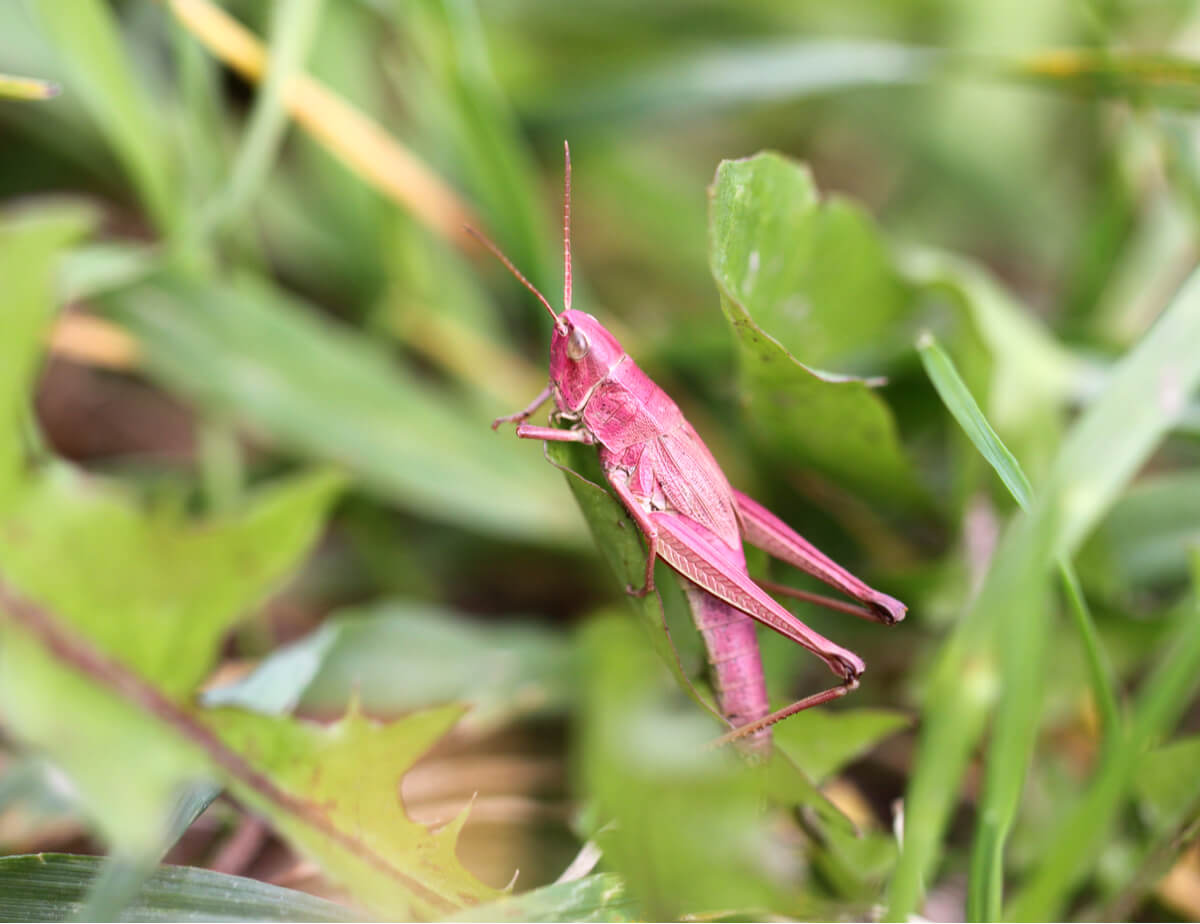The Pink Grasshopper: A Fascinating Find


Written and verified by biochemistry Luz Eduviges Thomas-Romero
The pink grasshopper is a rare insect that has been sighted on very few occasions. Daniel Tate, only 11 years old, had the honor of encountering this curious grasshopper in Devon, England. Daniel was attending a wildlife event in Seaton with his family when he spotted the insect.
Some living creatures attract attention because of their atypical coloration, as this grasshopper certainly stands out from any predator in an obvious way. Is this pink color an evolutionary strategy? What’s the reason for such a striking hue? Find out in the following lines.
The pink grasshopper: an incredible find
According to Daniel’s own words, the boy saw a pink flash and, at first, thought it was a flower. Later he saw it moving, so he tried to catch it. When it jumped, Daniel realized it was a grasshopper.
Of course, the boy was thrilled when, after inspection, local entomological experts told him that no one else had ever found one of these grasshoppers in that location.
Daniel caught the grasshopper and took it to local biodiversity experts, who verified that it was an adult female grasshopper. This insect owes its color to an unusual genetic mutation. Of course – after examination – the animal was returned to the nature reserve.
The Devon pink grasshopper is actually a longhorn grasshopper, which belongs to a rather large family called Tettigoniidae. Although most are green specimens, the curious color of this pink insect is the product of a mutation of the normal characteristics of the species.

More than just an atypical coloration
Adult male grasshoppers are almost always green. However, females may appear in a rainbow of shades, usually in colors tending toward brown or even purple. Usually, the females change color as time goes on.
Fraser Rush, nature reserves officer for East Devon District Council, in England, was on hand to release the results. Rush said that in all his years living in the district he had never seen such a specimen.
For him, even though it’s often possible to spot a purple female, there’s a big step between purple and pink. While the pinkish hue in grasshoppers isn’t completely unfamiliar, it’s the intensity of the pink that so surprised the experts.
Usually, as grasshoppers reach adulthood, the bright colors of youth tend to become dull shades in the brown and green range. However, a grasshopper that remains bright pink as an adult is likely to pass on the “pink gene ” to its offspring.
Another reason bright pink grasshoppers don’t usually reach adulthood is how exposed they are. In nature, possessing a very striking color that contrasts sharply with the environment is a sure way to be spotted by predators. A pink grasshopper in green foliage becomes easy prey.
So what’s the explanation for their color?
The reason behind the color of pink grasshoppers is erythrism, an unusual and poorly understood genetic mutation. Grasshopper erythrism appears to be caused by a dominant gene, which means that it’s easy for parents to transfer their color to offspring. However, the high mortality rate among specimens makes it unlikely that they’ll survive long enough to reproduce.
Little is known about pink grasshoppers, except that this mutation results in one or even a combination of the two occurring:
- A reduction or even absence of normal pigment, particularly black pigment.
- An excessive production of other pigments, in this case, red.
Reduced black pigment – combined with red super pigmentation – results in specimens of this magnificent pink color. Erythrism in grasshoppers was first described in 1887 in a species of longicorn grasshoppers.

Since that time, collectors and explorers have reported seeing pink grasshoppers only sporadically. This mutation in insects is extremely rare and seeing a pink grasshopper is undoubtedly a once-in-a-lifetime phenomenon.
The pink grasshopper is a rare insect that has been sighted on very few occasions. Daniel Tate, only 11 years old, had the honor of encountering this curious grasshopper in Devon, England. Daniel was attending a wildlife event in Seaton with his family when he spotted the insect.
Some living creatures attract attention because of their atypical coloration, as this grasshopper certainly stands out from any predator in an obvious way. Is this pink color an evolutionary strategy? What’s the reason for such a striking hue? Find out in the following lines.
The pink grasshopper: an incredible find
According to Daniel’s own words, the boy saw a pink flash and, at first, thought it was a flower. Later he saw it moving, so he tried to catch it. When it jumped, Daniel realized it was a grasshopper.
Of course, the boy was thrilled when, after inspection, local entomological experts told him that no one else had ever found one of these grasshoppers in that location.
Daniel caught the grasshopper and took it to local biodiversity experts, who verified that it was an adult female grasshopper. This insect owes its color to an unusual genetic mutation. Of course – after examination – the animal was returned to the nature reserve.
The Devon pink grasshopper is actually a longhorn grasshopper, which belongs to a rather large family called Tettigoniidae. Although most are green specimens, the curious color of this pink insect is the product of a mutation of the normal characteristics of the species.

More than just an atypical coloration
Adult male grasshoppers are almost always green. However, females may appear in a rainbow of shades, usually in colors tending toward brown or even purple. Usually, the females change color as time goes on.
Fraser Rush, nature reserves officer for East Devon District Council, in England, was on hand to release the results. Rush said that in all his years living in the district he had never seen such a specimen.
For him, even though it’s often possible to spot a purple female, there’s a big step between purple and pink. While the pinkish hue in grasshoppers isn’t completely unfamiliar, it’s the intensity of the pink that so surprised the experts.
Usually, as grasshoppers reach adulthood, the bright colors of youth tend to become dull shades in the brown and green range. However, a grasshopper that remains bright pink as an adult is likely to pass on the “pink gene ” to its offspring.
Another reason bright pink grasshoppers don’t usually reach adulthood is how exposed they are. In nature, possessing a very striking color that contrasts sharply with the environment is a sure way to be spotted by predators. A pink grasshopper in green foliage becomes easy prey.
So what’s the explanation for their color?
The reason behind the color of pink grasshoppers is erythrism, an unusual and poorly understood genetic mutation. Grasshopper erythrism appears to be caused by a dominant gene, which means that it’s easy for parents to transfer their color to offspring. However, the high mortality rate among specimens makes it unlikely that they’ll survive long enough to reproduce.
Little is known about pink grasshoppers, except that this mutation results in one or even a combination of the two occurring:
- A reduction or even absence of normal pigment, particularly black pigment.
- An excessive production of other pigments, in this case, red.
Reduced black pigment – combined with red super pigmentation – results in specimens of this magnificent pink color. Erythrism in grasshoppers was first described in 1887 in a species of longicorn grasshoppers.

Since that time, collectors and explorers have reported seeing pink grasshoppers only sporadically. This mutation in insects is extremely rare and seeing a pink grasshopper is undoubtedly a once-in-a-lifetime phenomenon.
All cited sources were thoroughly reviewed by our team to ensure their quality, reliability, currency, and validity. The bibliography of this article was considered reliable and of academic or scientific accuracy.
- Gilhen, J. (2010). Erythrism in the Maritime Garter Snake, Thamnophis sirtalis pallidulus , in Nova Scotia. Canadian Field-Naturalist, 124(2), 99–103.
- Mačát, Z., Hegner, D., & Jablonski, D. (2015). Erythrism in the Smooth Snake, Coronella austriaca (Laurenti, 1768), Recorded from Georgia. Russian Journal of Herpetology, 23(1), 73–76.
- Peter Underwood Centre. (2021) Pink sensation. The Wonder Weekly.
- Audubon Nature Institute. (2022). Audubon Butterfly Garden and Insectarium. Recuperado el 4 de junio de 2022, disponible en: https://audubonnatureinstitute.org/insectarium
This text is provided for informational purposes only and does not replace consultation with a professional. If in doubt, consult your specialist.








